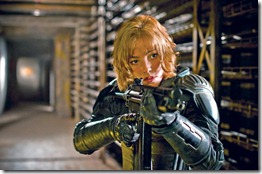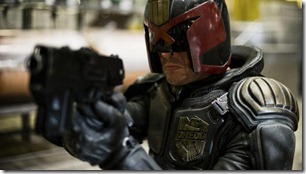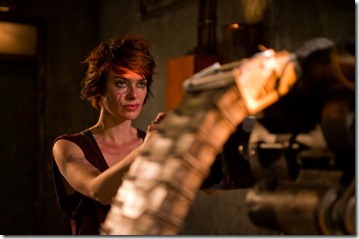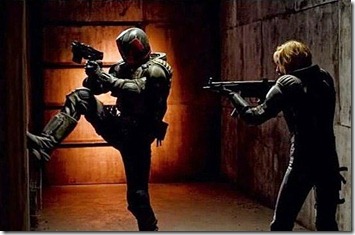The rebooted Judge Dredd movie, Dredd, is an action-packed ride that combines elements of the classic British series from the 2000AD magazine with the kind of triphammer percussiveness of Pantera. It doesn’t lay its Margaret Thatcher/Ronald Reagan government on steroids backdrop with a trowel, but the attitude of the comic is definitely the foundation for the film.
The world of Dredd is one in which a nuclear apocalypse has rendered most of North America a radioactive wasteland – referred to as The Cursed Earth – with the exception of a belt that stretches from Boston to Washington, DC. That area has become a vast ubercity, Mega City-1, home to 800,000,000 people – most housed in mega-sized city blocks of two hundred storeys.
Crime is rampant – 17,000 call-ins to the authorities every 24 hours; law enforcement can only respond to about 6%. Under these circumstances, law enforcement officers have been given the power of judge, jury and executioner. Called Judges, these individuals are quite literally The Law.
Judge Dredd (Karl Urban) is the most highly regarded – and feared – of the Judges, but in a world as savage as this, he’s a world-weary hero-by-default. He is not the kind of guy you invite over for dinner after work. He’s not even someone you associate with after work (or during, unless you’re his assigned partner, for that matter).
Dredd is about the events of one day in the life of Dredd – a particularly eventful day in which he is assigned a rookie partner for the purpose of assessing whether she is Judge material. Judge Anderson (Olivia Thirlby) is a mutant – though most mutants in this world are misshapen monstrosities, she looks completely normal. She’s just the most powerful psychic the Chief Judge (Rakie Ayola) has ever seen. So, despite missing a passing grade in training, she’s been given a second chance – with the toughest Judge in Mega-City-1 doing her assessment.
The pair takes a call to the scene of a triple homicide in the deceptively named Mega-Block, Peach Trees. Three men have been skinned alive, given shots of Slo-Mo and dropped into the block’s main floor plaza from a very great height. We’ve been introduced to Slo-Mo in the first few minutes of the movie, when Dredd chased down three men in a van – one of whom was huffing the drug.
Slo-Mo has become popular because it slows the mind’s perception of reality to 1% of its actual speed. The result is that, in a world of staggeringly hopelessness and ugliness, users can find moments of beauty in the strangest places – something we see, graphically, in 3D slow motion as various acts (ranging from a hand splashing water in a bath, to bullets passing through a perp’s face).
An arrest at the scene causes the building’s crime lord, Ma-Ma (Lena Headey) to lock the building down and make the Judges targets. To get to her, they will have to survive being hunted by hundreds of Ma-Ma’s men – while trying to get to the building’s two hundredth floor.
That sounds a lot like a movie that was released earlier this year: The Raid Redemption, but it should be noted that Dredd is based, in part, on a graphic novel from the eighties and that Gareth Edwards, the director of The Raid: Redemption is Welsh as read 2000AD (and therefore, Judge Dredd) when he was a kid). It should also be noted that Dredd started filming well before Edwards’ film was released.
Essentially a dystopic character study, wherein we learn about the characters as they fight for their lives (or, in Ma-Ma’s case, to take their lives), Dredd isn’t a flashy, showy set of action set pieces that escalate exponentially until a final huge blowout. While there is some flash (a sequence in which Dredd directs his weapon to discharge an incendiary device), the action never really reaches amazing heights because it begins at intense and stays there. The result is a film that is like the constant percussion of a jackhammer, rather than a series of build-and-release action set pieces.
Through the intense action and graphic violence we learn about where Anderson came from and why she wants to be a Judge. We see her go from jumpy rookie to almost remorseful executioner. We get a sense of who Dredd is, but only a sense. In his case, what matters is the law – and he is the law, no matter what might be going on under his iconic helmet. He is laconic and dispenses justice without quips or any sign of enjoying his work. His being so seemingly dispassionate about his work is framed by an early demonstration of Anderson’s abilities before the Chief Judge orders her to stop.
Ma-Ma is a character who exists mostly as a plot device, but Headey gives her substance and makes us believe her backstory – Ma-Ma was a prostitute who left the sex trade when her pimp cut her up. She killed him and took over his business, branching into drugs and finally, cornering the market on Slo-Mo.
Considering the murky world inside Peach Trees (lockdown entails massive blast shields sealing off every door and window in the building), the 3D is extremely good – and especially effective during the Slo-Mo sequences.
The script, by Alex Garland, may not have the most dialogue ever seen in a dystopic, post-apocalyptic action flick, but it gets the job done at a level well above serviceable. Pete Travis directs with the blunt power of the abovementioned jackhammer. The film’s infrequent more slowly paced moments allow some deeper character beats, but they only last about the same proportionate time as those moments when a jackhammer operator pauses to take a breath before pounding onward.
Garland and Travis, it should be noted, pepper the film with the black-as-night/cold-as-ice/dry-as-a-desert humor that gives the comics their unexpected satirical power. Indeed, the very terseness of Dredd is frequently hilarious in the darkest possible way – and the one time he goes so far as to explain himself results in one of the movie’s best moments.
Urban plays Dredd as drily as the script makes possible. Since he never takes off his helmet – and never talks about anything non-work related, he has to communicate every emotion with his mouth and jawline (and a perfectly realized three-day stubble that is almost a character in itself). Somehow, he pulls it off.
I would never have cast Thirlby as Anderson, whom the comics depict as classically beautiful. Thirlby is a different kind of beautiful – a unique individual rather than someone in a fashionable mold – but she captures the character impeccably. Anderson’s journey from jittery, adrenalized, and more than a bit terrified, to assured and proactive Judge may take place over one day, but Thirlby makes us believe it. Now, I can’t picture anyone else in the role.
Dredd falls a bit short of being a masterpiece, but it is a smart, sharp, totally credible adaptation of a comic that has been badly done by in the past (I’m looking at you, Mr. Stallone!). It should remove the metaphorical taste left by the first attempt to capture the character. It certainly deserves to be successful.
Final Grade: A-



